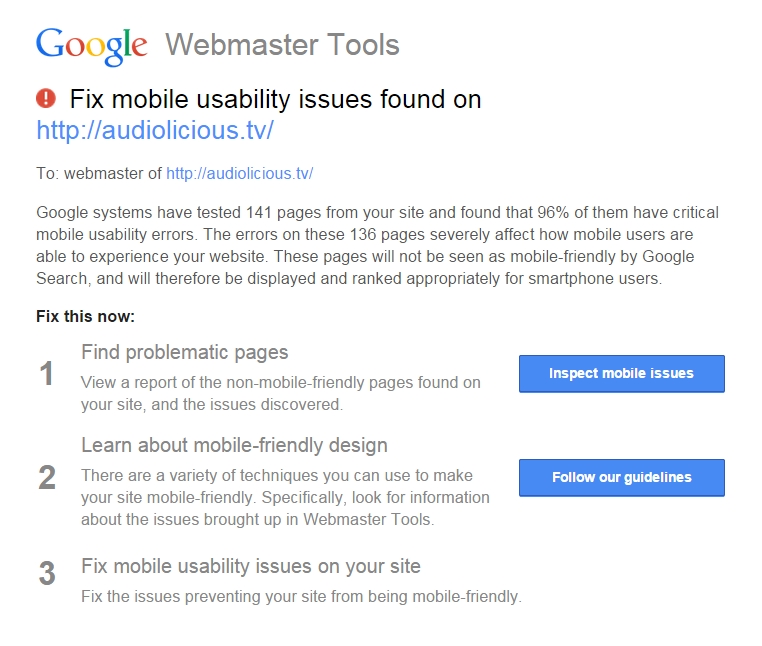
Google has been emphasizing the importance of mobile-friendliness as a ranking factor in mobile search for years. It has also been generally accepted among us search engine marketers that mobile-friendly websites likely get a boost in desktop search visibility, as well.
But Google has stepped up its emphasis on mobile sites; earlier this year, Google Webmaster Tools account-holders started getting emails for their websites that weren’t up to Google’s mobile standards. Here’s an email I received for one of my sites:

Yeah, yeah, I know, Google! So I’ve got that to do.
It’s not like Google didn’t give me fair warning, though. I received this email in mid-February, so the warning was well before Google’s official announcement that webmasters have until April 21 to get their sites mobile-friendly before being penalized in search.
How Will Google Penalize Mobile Unfriendly Websites?
No one knows for sure because Google doesn’t release specifics about the workings of their search algorithm.
The likely and most logical result, however, will be that your site will cease to show up for most queries it previously ranked for in mobile search. You may lose some search visibility for desktop searches as well.
Why Is Google Forcing People To Make Their Websites Mobile Friendly?
Why? Here are a few reasons:
Mobile Share Of Site Visits By Industry
Adobe’s Best of the Best (U.S.) Digital Marketing report reveals that smartphone and tablet visit shares are up in each of six industries Adobe analyzed.
US Search Users & Mobile Phone Searchers By 2019
Mobile search users will largely close the gap between desktop searchers in four years.
Mobile Share Of Search Ad Spending & Clicks
And this, ultimately, is the bottom-line reason Google wants your website mobile-friendly: Mobile increased its share of paid search clicks by six percentage points in North America between Q4 2013 and Q4 2014, from one-third to nearly 40%, according to data released in January 2015 by Merkle|RKG.
What Makes A Website Mobile-Friendly?
There are three primary factors that makes a website mobile-friendly:
- Loads quickly
- Is easy to use on a mobile device
- Multimedia displays properly
What Can Cause A Website To Be Considered Unfriendly To Mobile Devices?
These are some of the areas you’ll want to look at when evaluating your site:
Load Times
The length of time it takes a web page to load in a browser is a major factor in mobile search ranking because it is a usability issue.
People much less tolerance for pages that take a long time to load on desktops, let alone on mobile devices. Google recommends a mobile load time of less than one second.
Factors that can slow your site down include large graphics that have not been optimized for mobile devices, scripts for things like website tracking services, or large multimedia files like MP4 video files.
Ease Of Use
This is exactly what you might imagine it to be. Simply speaking, is your website easy to use on a smartphone or a tablet? Can visitors easily find what they’re looking for? Are the navigation buttons easy to use? Can you view multimedia content such as videos or do they take forever to download?
Responsive Website Design
The best practice for making your website mobile friendly is to adopt responsive website design. Responsive websites respond to the device upon which it is being viewed, adapting the layout of the site to be viewed on a desktop or laptop computer versus a tablet or a smartphone.
This infographic from Verve explains how responsive design works:

Here is what the Karwoski & Courage website looks like on a smartphone. Notice that the navigation buttons at the top have disappeared and have been replaced with a search box. The site layout has responded to the needs of the mobile device.

How Do I Know If My Website Is Mobile Friendly?
Use Google’s Mobile-Friendly Test Tool we wrote about this week for a quick diagnosis and then follow Google’s Mobile-Friendly Websites guide.
And, as always, if you need help navigating your transition to a mobile website, I am happy to guide you.
The e-Strategy Academy covers all aspects of digital marketing including search optimization & marketing, email marketing, social media marketing, video marketing, mobile marketing & public relations.


